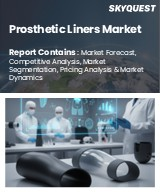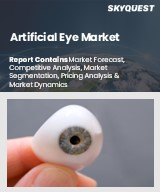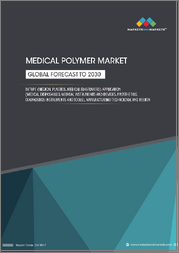
|
시장보고서
상품코드
1610875
세계의 교정 기기 시장 : 인사이트, 경쟁 환경 및 시장 예측(-2030년)Orthotic Devices - Market Insights, Competitive Landscape, and Market Forecast - 2030 |
||||||
교정용 기기 시장 규모는 2023년 25억 1,000만 달러에 달했습니다. 이 시장은 2024년부터 2030년까지 예측 기간 동안 5.13%의 연평균 복합 성장률(CAGR)로 성장하여 2030년에는 33억 8,000만 달러에 달할 것으로 예상됩니다. 교정 기기 시장은 몇 가지 중요한 요인에 의해 크게 촉진되고 있습니다. 골관절염, 골다공증, 류마티스 관절염과 같은 퇴행성 뼈 질환과 뇌성 마비, 다발성 경화증, 근이영양증과 같은 근육 질환과 같은 상태는 근육을 조절하는 신경계의 능력에 영향을 미쳐 운동과 협응력 장애로 이어집니다. 이러한 질환을 앓고 있는 환자들은 움직임을 보조하고, 지지하며, 기능적 결과를 개선하기 위해 보조기구가 필요한 경우가 많습니다. 이러한 이유로 특수 교정 솔루션에 대한 수요가 증가하고 있습니다.
교통 사고, 낙상 및 기타 외상 증가로 인해 골절, 관절 손상 및 연조직 손상의 발생률이 증가하여 교정 장비 시장이 더욱 확대되고 있습니다. 또한 스포츠 및 신체 활동의 인기가 높아짐에 따라 염좌, 염좌 및 골절과 같은 스포츠 관련 부상의 발생률이 증가하고 있습니다. 또한, 기술 및 재료의 발전으로 보다 효과적이고 사용하기 쉬운 교정 장치가 개발되고 있습니다. 맞춤형 3D 프린팅 교정기, 통합 센서가 장착된 스마트 교정기, 더 나은 성능과 환자 편의성에 기여하는 개선된 소재와 같은 기술 혁신도 2024-2030년의 예측 기간 동안 교정기 시장 확대에 기여하고 있습니다.
세계보건기구(WHO)의 최신 데이터(2023년)에 따르면, 전 세계적으로 약 180만 명이 다발성 경화증(MS)을 앓고 있으며, 이 질환은 면역체계가 뇌와 척수를 공격하는 질환입니다. 이 질환은 인지, 감정, 운동, 감각, 시각 등 다양한 영역의 기능을 손상시킬 수 있습니다. 따라서 교정 기기는 증상 관리, 합병증 예방, MS 환자의 삶의 질 향상에 도움이 되어 전체 시장을 견인하고 있습니다.
또한, 같은 자료에 따르면 전 세계 인구 중 약 13억 명이 심각한 장애를 경험하고 있습니다. 장애 증가는 다양한 장애에 대한 효과적인 지원과 관리의 필요성으로 인해 교정 기기에 대한 수요를 증가시킬 것입니다. 특히 다발성 경화증, 뇌졸중, 부상과 같은 증상으로 인한 장애 증가. 이는 더 많은 맞춤형 솔루션, 연구 개발에 대한 투자 확대, 건강 관리 적용 범위 확대 및 전체 시장 성장으로 이어질 것입니다.
이 보고서는 세계 교정 기기 시장을 조사했으며, 시장 개요와 함께 기능별/제품 유형별/맞춤형별/최종 사용자별/지역별 동향, 시장 진출기업 프로파일 등의 정보를 제공합니다.
목차
제1장 교정 기기 시장 보고서 서론
제2장 교정 기기 시장 주요 요약
제3장 경쟁 구도
제4장 규제 분석
- 미국
- 유럽
- 일본
- 중국
제5장 교정 기기 시장의 주요 요인 분석
- 교정 기기 시장 성장 촉진요인
- 교정 기기 시장 성장 억제요인과 과제
- 교정 기기 시장 기회
제6장 교정 기기 시장 : Porter의 Five Forces 분석
제7장 교정 기기 시장 평가
- 기능별
- 제품 유형별
- 커스터마이즈별
- 최종사용자별
- 지역별
제8장 교정 기기 시장 기업과 제품 개요
- Ottobock
- Boston Orthotics & Prosthetics
- LeTourneau Prosthetics and Orthotics
- B BOUNDLESS BIOMECHANICAL BRACING INC.
- Becker Orthopedic
- Trulife
- Hanger Clinic
- Fillauer LLC
- Basko Healthcare
- Bauerfeind.
- DJO, LLC
- Acor Orthopaedic, Inc.
- Aspen Medical Products, LLC
- Aetrex Worldwide, Inc.
- Allard USA Inc.
- Steeper Inc.
- ORTHOMERICA PRODUCTS, INC.
- Conwell Medical Co., Ltd.
- Kinetec Medical Products UK Ltd
- Breg, Inc.
제9장 KOL(Key Opinion Leader)의 견해
제10장 프로젝트 접근
제11장 DelveInsight에 대해
제12장 면책사항과 문의
LSH 24.12.24Orthotics Devices by Functionality (Static Orthotic Devices and Dynamic Orthotic Devices), Product Type (Upper Limb Orthotic Devices [Shoulder, Elbow, Hand & Wrist, and Finger], Lower Limb Orthotic Devices [Foot & Ankle, Knee, Hip, and Others], Spinal Orthotic Devices [Cervical Orthotic Devices, Lumbosacral Orthotic Devices, and Others]), Customization (Prefabricated and Customized), End-User (Hospitals & Clinics, Ambulatory Surgical Centers, Homecare Settings, and Others), and Geography (North America, Europe, Asia-Pacific, and Rest of the World) is expected to grow at a steady CAGR forecast till 2030 owing to the increase in prevalence of degenerative bone disorders and neuromuscular disorders, rising number of trauma and accident cases, growing number of sports-related injuries, and increased in product developmental activities across the globe.
The orthotic devices market was valued at USD 2.51 billion in 2023, growing at a CAGR of 5.13% during the forecast period from 2024 to 2030 to reach USD 3.38 billion by 2030. The market for orthotic devices is significantly boosted by several key factors. Conditions like degenerative bone disorders such as osteoarthritis, osteoporosis, and rheumatoid arthritis and conditions like muscular disorders such as cerebral palsy, multiple sclerosis, and muscular dystrophy affect the nervous system's ability to control muscles, leading to impaired movement and coordination. Patients with these conditions often require orthotic devices to assist with movement, provide support, and improve functional outcomes. This drives demand for specialized orthotic solutions. Increasing road traffic accidents, falls, and other traumatic injuries contribute to a higher incidence of bone fractures, joint injuries, and soft tissue damage which further escalate the market of orthotic devices. Additionally, the growing popularity of sports and physical activities leads to a higher incidence of sports-related injuries, such as sprains, strains, and fractures. Furthermore, advances in technology and materials have led to the development of more effective and user-friendly orthotic devices. Innovations such as custom 3D-printed orthotics, smart orthoses with integrated sensors, and improved materials contribute to better performance and patient comfort also contribute to the expanding market for orthotics devices during the forecast period from 2024 to 2030.
Orthotics Devices Market Dynamics:
According to the latest data provided by the World Health Organization (2023), globally, approximately 1.8 million people are affected by multiple sclerosis (MS), a condition in which the immune system attacks the brain and spinal cord. This disease can impair functions across cognitive, emotional, motor, sensory, and visual domains. Thus, orthotic devices can help manage symptoms, prevent complications, and improve the quality of life for MS patients thereby boosting the overall market.
Additionally, as per the same source, approximately 1.3 billion global population experience significant disability. The increase in disability drives up the demand for orthotic devices due to the need for effective support and management of various impairments. An increase in disability, particularly due to conditions such as multiple sclerosis, stroke, or injuries. This leads to more customized solutions, greater investment in research and development, expanded healthcare coverage, and overall market growth.
According, to the data provided by the World Health Organization (WHO) (2024), in 2021 globally approximately 15.1 million people were living with spinal cord injury. Spinal cord injuries often lead to varying degrees of paralysis, spasticity, and compromised motor functions, necessitating the use of orthotic devices to support, stabilize, and enhance movement. This increased need for assistive technology drives demand for a range of orthotic solutions, such as custom braces, mobility aids, and exoskeletons designed to facilitate movement and improve quality of life.
Furthermore, as per the data provided by the World Health Organization (WHO) 2023, approximately 20 to 50 million people suffer from non-fatal road traffic accidents worldwide, every year. Accidents frequently lead to musculoskeletal injuries, fractures, and soft tissue damage that necessitate the use of orthotics to support healing, restore function, and manage pain. As a result, there is increased demand for various orthotic devices thus escalating the overall market.
Additionally, companies are amplifying their production of orthotics devices and launching the new products, thereby strategically expanding their market presence and driving further growth. For instance, in October, 2023, Ottobock, launched IX BACK AIR exoskeleton, SUITX. The new back-support exoskeleton which combines the power of rigid systems with the comfort of soft models. This makes it exoskeleton to be used across the board in the logistics industry.
Thus, the factors mentioned above are likely to boost the market of orthotics devices during the forecasted period.
However, side effects associated with prolonged use of braces and support systems and issues related to customization and fitting may hinder the future market of orthotics devices.
Orthotics Devices Market Segment Analysis:
Orthotics Devices by Functionality (Static Orthotic Devices and Dynamic Orthotic Devices), Product Type (Upper Limb Orthotic Devices [Shoulder, Elbow, Hand & Wrist, and Finger], Lower Limb Orthotic Devices [Foot & Ankle, Knee, Hip, and Others], Spinal Orthotic Devices [Cervical Orthotic Devices, Lumbosacral Orthotic Devices, and Others]), Customization (Prefabricated and Customized), End User (Hospitals & Clinics, Ambulatory Surgical Centers, Homecare Settings, and Others), and Geography (North America, Europe, Asia-Pacific, and Rest of the World)
In the functionality segment of orthotics devices market the spinal orthotic devices are expected to hold a significant share in 2023. Spinal orthotic devices are significantly boosting the overall market for orthotic devices due to their critical role in managing spinal disorders and injuries. The rising incidence of spinal disorders contributes to a growing demand for spinal orthotic devices. These devices help manage pain, stabilize the spine, and support recovery, thereby driving market growth. As per the recent data provided by the Australian Institute of Health and Welfare, in 2021-2022, hospitalizations for spine-related disorders were primarily due to spine pain, accounting for 52% of cases. This included lower back pain (27%), neck pain (6.2%), and radiculopathy (6.0%). Additionally, vertebrae and disc disorders made up 43% of hospitalizations, with spinal stenosis (11%), lumbar and other intervertebral disc disorders with radiculopathy (8.9%), and spondylosis (8.7%) being the most common conditions.
Additionally, advances in materials and technology have led to the development of sophisticated spinal orthotic devices. Innovations such as 3D printing, lightweight materials, and smart sensors improve the comfort, effectiveness, and adaptability of these devices. This technological progress attracts both healthcare providers and patients, expanding the market. Spinal orthotic devices play a crucial role in rehabilitation by providing necessary support and stability. They help reduce pain, prevent further injury, and promote faster recovery, which drives demand in both clinical and home settings.
In addition, new product launches are also likely to upsurge the global spinal orthotics devices market during the forecasted period. For instance, in February 2021, Breg, Inc. launched 15 new spine bracing products in two product lines- Pinnacle and Ascend(TM).
Hence, all the above-mentioned factors are expected to generate considerable revenue of the segment pushing the overall growth of the global orthotics devices market during the forecast period.
North America is expected to dominate the overall orthotics devices market:
North America is expected to account for the highest proportion of the Orthotics Devices market in 2023, out of all regions. This can be ascribed to the increasing prevalence of muscular dystrophy, degenerative bone disorders impairment disabilities, paralysis, and spinal cord injuries. Additionally, the presence of key market players engaged in merges, acquisition, product launches, and other market activities across the region are expected to escalate the market of orthotics devices during the forecast period.
According to the data provided by the Muscular Dystrophy Organization (2023), the prevalence of Duchene Muscular Dystrophy is 6 per 100,000 individuals in North America. It is a rare neuromuscular disorder where in the muscles of upper arm, thighs, and hips are affected in early stages thereby boosting the overall market of orthotic devices across the region.
According to the data provided by the Centre for Disease Control and Prevention (2023), up to 27% of U.S. adults reported having some type of disability, with 12.1% experiencing mobility disabilities characterized by serious difficulty in walking or climbing stairs. Disabilities often result in mobility impairments, joint instability, and muscle weakness, creating a heightened need for orthotic devices. These devices, such as braces, splints, and supports, are essential for improving function, reducing pain, and enhancing quality of life for individuals with disabilities.
Additionally, as per the data provided by the United Spinal Association in the year 2022, around 17,700 Americans suffered spinal cord injuries annually, with 78% of cases occurring in men at an average age of 43. Vehicular accidents account for 39.3% of injuries, followed by falls at 31.8%, violence at 13.2%, sports at 8%, and medical/surgery at 4.3%. Spinal cord injuries often result in varying degrees of paralysis, muscle weakness, and loss of function below the level of injury. This creates a high demand for orthotic devices designed to support, stabilize, and enhance mobility for affected individuals. Orthotic devices, such as spinal braces, lumbar supports, and custom splints, play a critical role in managing the physical challenges associated with spinal cord injury, driving market growth.
Therefore, the above-mentioned factors are expected to bolster the growth of the orthotics devices market in the North America during the forecast period.
Orthotics Devices Market Key Players:
Some of the key market players operating in the Orthotics Devices market include Ottobock, Boston Orthotics & Prosthetics, LeTourneau Prosthetics and Orthotics, B BOUNDLESS BIOMECHANICAL BRACING INC., Becker Orthopedic, Trulife, Hanger Clinic, Fillauer LLC, Basko Healthcare, Bauerfeind, Breg, Inc, DJO, LLC, Acor Orthopaedic, Inc., Aspen Medical Products, LLC, Aetrex Worldwide, Inc. Allard USA Inc, Steeper Inc, ORTHOMERICA PRODUCTS, INC, Conwell Medical Co., Ltd, Kinetec Medical Products UK Ltd., and others.
Recent Developmental Activities in the Orthotics Devices Market:
- In January 2024, UNFO introduces innovative corrective foot brace for newborns, elevating pediatric orthopedic care in the U.S.
- In October 2023, Blatchford, the renowned prosthetics manufacturer, launched Tectus(R)-an intelligent orthotic device that helps individuals with partial lower limb paralysis walk more easily, naturally, and comfortably, enhancing their confidence and safety.
Key Takeaways From the Orthotics Devices Market Report Study:
- Market size analysis for current orthotics devices size (2023), and market forecast for 6 years (2024 to 2030)
- Top key product/technology developments, mergers, acquisitions, partnerships, and joint ventures happened for the last 3 years
- Key companies dominating the orthotics devices market.
- Various opportunities available for the other competitors in the orthotics devices market space.
- What are the top-performing segments in 2023? How these segments will perform in 2030?
- Which are the top-performing regions and countries in the current orthotics devices market scenario?
- Which are the regions and countries where companies should have concentrated on opportunities for orthotics devices market growth in the coming future?
Target Audience who can be Benefited From This Orthotics Devices Market Report Study:
- Orthotics devices product providers
- Research organizations and consulting companies
- Orthotics devices -related organizations, associations, forums, and other alliances
- Government and corporate offices
- Start-up companies, venture capitalists, and private equity firms
- Distributors and traders dealing in orthotics devices
- Various end-users who want to know more about the orthotics devices market and the latest technological developments in the orthotics devices market. .
Frequently Asked Questions for the Orthotics Devices Market:
1. What are orthotics devices?
Orthotic devices are specialized medical tools designed to support, align, correct, or enhance the function of a specific body part, typically used to manage injuries, deformities, or disabilities.
2. What is the market for orthotics devices?
The orthotic devices market was valued at USD 2.51 billion in 2023, growing at a CAGR of 5.13% during the forecast period from 2024 to 2030 to reach USD 3.38 billion by 2030.
3. What are the drivers for the orthotics devices market?
The market for orthotic devices is significantly boosted by several key factors. Conditions like degenerative bone disorders such as osteoarthritis, osteoporosis, and rheumatoid arthritis and conditions like muscular disorders such as cerebral palsy, multiple sclerosis, and muscular dystrophy affect the nervous system's ability to control muscles, leading to impaired movement and coordination. Patients with these conditions often require orthotic devices to assist with movement, provide support, and improve functional outcomes. This drives demand for specialized orthotic solutions. Increasing road traffic accidents, falls, and other traumatic injuries contribute to a higher incidence of bone fractures, joint injuries, and soft tissue damage which further escalate the market of orthotic devices. Additionally, the growing popularity of sports and physical activities leads to a higher incidence of sports-related injuries, such as sprains, strains, and fractures. Furthermore, advances in technology and materials have led to the development of more effective and user-friendly orthotic devices. Innovations such as custom 3D-printed orthotics, smart orthoses with integrated sensors, and improved materials contribute to better performance and patient comfort also contribute to the expanding market for orthotics devices during the forecast period from 2024 to 2030.
4. Who are the key players operating in the orthotics devices market?
Some of the key market players operating in the Orthotics Devices market include Ottobock, Boston Orthotics & Prosthetics, LeTourneau Prosthetics and Orthotics, B BOUNDLESS BIOMECHANICAL BRACING INC., Becker Orthopedic, Trulife, Hanger Clinic, Fillauer LLC, Basko Healthcare, Bauerfeind, Breg, Inc, DJO, LLC, Acor Orthopaedic, Inc., Aspen Medical Products, LLC, Aetrex Worldwide, Inc. Allard USA Inc, Steeper Inc, ORTHOMERICA PRODUCTS, INC, Conwell Medical Co., Ltd, Kinetec Medical Products UK Ltd., and others.
5. Which region has the highest share in the orthotics devices market?
North America is expected to account for the highest proportion of the Orthotics Devices market in 2023, out of all regions. This can be ascribed to the increasing prevalence of muscular dystrophy, degenerative bone disorders impairment disabilities, paralysis, and spinal cord injuries. Additionally, the presence of key market players engaged in merges, acquisition, product launches, and other market activities across the region are expected to escalate the market of orthotics devices during the forecast period.
Table of Contents
1. Orthotics Devices Market Report Introduction
- 1.1. Scope of the Study
- 1.2. Market Segmentation
- 1.3. Market Assumption
2. Orthotics Devices Market Executive Summary
- 2.1. Market at Glance
3. Competitive Landscape
4. Regulatory Analysis
- 4.1. The United States
- 4.2. Europe
- 4.3. Japan
- 4.4. China
5. Orthotics Devices Market Key Factors Analysis
- 5.1. Orthotics Devices Market Drivers
- 5.1.1. The increase in prevalence of degenerative bone disorders and neuromuscular disorders
- 5.1.2. Rising number of trauma and accident cases
- 5.1.3. Growing number of sports-related injuries
- 5.1.4. Increased in product developmental activities across the globe.
- 5.2. Orthotics Devices Market Restraints and Challenges
- 5.2.1. The side effects associated with prolonged use of braces and support systems
- 5.2.2. Issues related to customization and fitting
- 5.3. Orthotics Devices Market Opportunities
- 5.3.1. The increase in adoption of custom fittings in orthopedic braces and support systems
6. Orthotics Devices Market Porter's Five Forces Analysis
- 6.1. Bargaining Power of Suppliers
- 6.2. Bargaining Power of Consumers
- 6.3. Threat of New Entrants
- 6.4. Threat of Substitutes
- 6.5. Competitive Rivalry
7. Orthotics Devices Market Assessment
- 7.1. By Functionality
- 7.1.1. Static Orthotic Devices
- 7.1.2. Dynamic Orthotic Devices
- 7.2. By Product Type
- 7.2.1. Upper Limb Orthotic Devices
- 7.2.1.1. Shoulder
- 7.2.1.2. Elbow
- 7.2.1.3. Hand & Wrist
- 7.2.1.4. Finger
- 7.2.2. Lower Limb Orthotic Device
- 7.2.2.1. Foot & Ankle
- 7.2.2.2. Knee
- 7.2.2.3. Hip
- 7.2.2.4. Others
- 7.2.3. Spinal Orthotic Device
- 7.2.3.1. Cervical
- 7.2.3.2. Lumbosacral
- 7.2.3.3. Others
- 7.2.1. Upper Limb Orthotic Devices
- 7.3. By Customization
- 7.3.1. Pre-Fabricated
- 7.3.2. Customized
- 7.4. By End-User
- 7.4.1. Hospitals & Clinics
- 7.4.2. Ambulatory Surgical Centers
- 7.4.3. Homecare Settings
- 7.4.4. Others
- 7.5. By Geography
- 7.5.1. North America
- 7.5.1.1. United States Orthotics Devices Market Size in USD Million (2021-2030)
- 7.5.1.2. Canada Orthotics Devices Market Size in USD Million (2021-2030)
- 7.5.1.3. Mexico Orthotics Devices Market Size in USD Million (2021-2030)
- 7.5.2. Europe
- 7.5.2.1. France Orthotics Devices Market Size in USD Million (2021-2030)
- 7.5.2.2. Germany Orthotics Devices Market Size in USD Million (2021-2030)
- 7.5.2.3. United Kingdom Orthotics Devices Market Size in USD Million (2021-2030)
- 7.5.2.4. Italy Orthotics Devices Market Size in USD Million (2021-2030)
- 7.5.2.5. Spain Orthotics Devices Market Size in USD Million (2021-2030)
- 7.5.2.6. Rest of Europe Orthotics Devices Market Size in USD Million (2021-2030)
- 7.5.3. Asia-Pacific
- 7.5.3.1. China Orthotics Devices Market Size in USD Million (2021-2030)
- 7.5.3.2. Japan Orthotics Devices Market Size in USD Million (2021-2030)
- 7.5.3.3. India Orthotics Devices Market Size in USD Million (2021-2030)
- 7.5.3.4. Australia Orthotics Devices Market Size in USD Million (2021-2030)
- 7.5.3.5. South Korea Orthotics Devices Market Size in USD Million (2021-2030)
- 7.5.3.6. Rest of Asia-Pacific Orthotics Devices Market Size in USD Million (2021-2030)
- 7.5.4. Rest of the World (RoW)
- 7.5.4.1. Middle East Orthotics Devices Market Size in USD Million (2021-2030)
- 7.5.4.2. Africa Orthotics Devices Market Size in USD Million (2021-2030)
- 7.5.4.3. South America Orthotics Devices Market Size in USD Million (2021-2030)
- 7.5.1. North America
8. Orthotics Devices Market Company and Product Profiles
- 8.1. Ottobock
- 8.1.1. Company Overview
- 8.1.2. Company Snapshot
- 8.1.3. Financial Overview
- 8.1.4. Product Listing
- 8.1.5. Entropy
- 8.2. Boston Orthotics & Prosthetics
- 8.2.1. Company Overview
- 8.2.2. Company Snapshot
- 8.2.3. Financial Overview
- 8.2.4. Product Listing
- 8.2.5. Entropy
- 8.3. LeTourneau Prosthetics and Orthotics
- 8.3.1. Company Overview
- 8.3.2. Company Snapshot
- 8.3.3. Financial Overview
- 8.3.4. Product Listing
- 8.3.5. Entropy
- 8.4. B BOUNDLESS BIOMECHANICAL BRACING INC.
- 8.4.1. Company Overview
- 8.4.2. Company Snapshot
- 8.4.3. Financial Overview
- 8.4.4. Product Listing
- 8.4.5. Entropy
- 8.5. Becker Orthopedic
- 8.5.1. Company Overview
- 8.5.2. Company Snapshot
- 8.5.3. Financial Overview
- 8.5.4. Product Listing
- 8.5.5. Entropy
- 8.6. Trulife
- 8.6.1. Company Overview
- 8.6.2. Company Snapshot
- 8.6.3. Financial Overview
- 8.6.4. Product Listing
- 8.6.5. Entropy
- 8.7. Hanger Clinic
- 8.7.1. Company Overview
- 8.7.2. Company Snapshot
- 8.7.3. Financial Overview
- 8.7.4. Product Listing
- 8.7.5. Entropy
- 8.8. Fillauer LLC
- 8.8.1. Company Overview
- 8.8.2. Company Snapshot
- 8.8.3. Financial Overview
- 8.8.4. Product Listing
- 8.8.5. Entropy
- 8.9. Basko Healthcare
- 8.9.1. Company Overview
- 8.9.2. Company Snapshot
- 8.9.3. Financial Overview
- 8.9.4. Product Listing
- 8.9.5. Entropy
- 8.10. Bauerfeind.
- 8.10.1. Company Overview
- 8.10.2. Company Snapshot
- 8.10.3. Financial Overview
- 8.10.4. Product Listing
- 8.10.5. Entropy
- 8.11. DJO, LLC
- 8.11.1. Company Overview
- 8.11.2. Company Snapshot
- 8.11.3. Financial Overview
- 8.11.4. Product Listing
- 8.11.5. Entropy
- 8.12. Acor Orthopaedic, Inc.
- 8.12.1. Company Overview
- 8.12.2. Company Snapshot
- 8.12.3. Financial Overview
- 8.12.4. Product Listing
- 8.12.5. Entropy
- 8.13. Aspen Medical Products, LLC
- 8.13.1. Company Overview
- 8.13.2. Company Snapshot
- 8.13.3. Financial Overview
- 8.13.4. Product Listing
- 8.13.5. Entropy
- 8.14. Aetrex Worldwide, Inc.
- 8.14.1. Company Overview
- 8.14.2. Company Snapshot
- 8.14.3. Financial Overview
- 8.14.4. Product Listing
- 8.14.5. Entropy
- 8.15. Allard USA Inc.
- 8.15.1. Company Overview
- 8.15.2. Company Snapshot
- 8.15.3. Financial Overview
- 8.15.4. Product Listing
- 8.15.5. Entropy
- 8.16. Steeper Inc.
- 8.16.1. Company Overview
- 8.16.2. Company Snapshot
- 8.16.3. Financial Overview
- 8.16.4. Product Listing
- 8.16.5. Entropy
- 8.17. ORTHOMERICA PRODUCTS, INC.
- 8.17.1. Company Overview
- 8.17.2. Company Snapshot
- 8.17.3. Financial Overview
- 8.17.4. Product Listing
- 8.17.5. Entropy
- 8.18. Conwell Medical Co., Ltd.
- 8.18.1. Company Overview
- 8.18.2. Company Snapshot
- 8.18.3. Financial Overview
- 8.18.4. Product Listing
- 8.18.5. Entropy
- 8.19. Kinetec Medical Products UK Ltd
- 8.19.1. Company Overview
- 8.19.2. Company Snapshot
- 8.19.3. Financial Overview
- 8.19.4. Product Listing
- 8.19.5. Entropy
- 8.20. Breg, Inc.
- 8.20.1. Company Overview
- 8.20.2. Company Snapshot
- 8.20.3. Financial Overview
- 8.20.4. Product Listing
- 8.20.5. Entropy



















